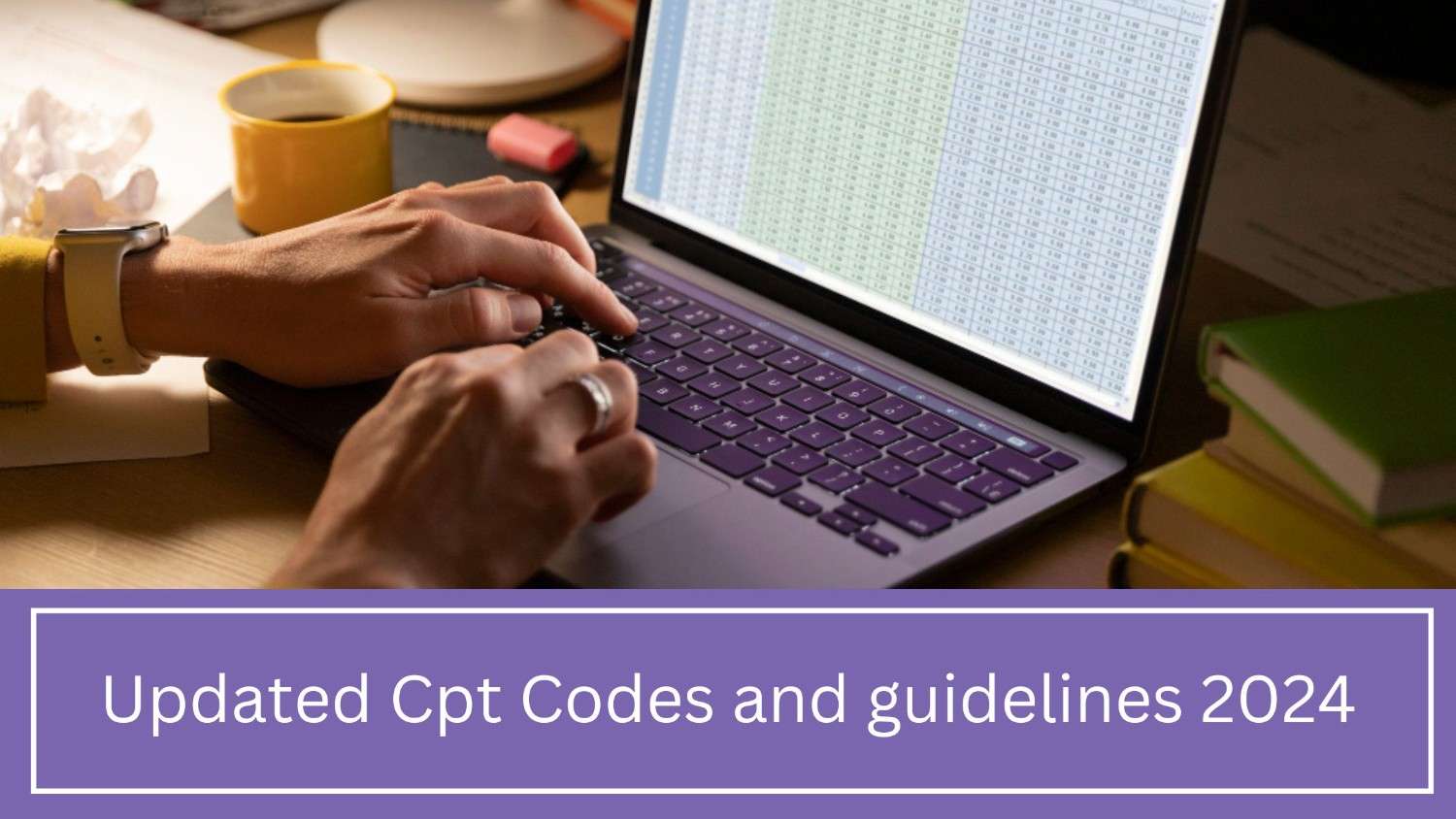Updated Cpt Codes and guidelines 2024
Every New Year heralds the arrival of updated CPT codes and guidelines 2024 effective from January 1. CPT 2024 brings substantial changes: 230 new codes/updated, 70 revisions, and 49 deletions. Notably, anesthesia, integumentary, digestive, male genital, and auditory systems see no alterations. The spotlight shines on pivotal areas like E/M services, phrenic nerve stimulation, lab/pathology, COVID-19/RSV vaccinations, and Category III codes. Below is a section-wise overview of these transformative changes.
Table of Contents
Revised Evaluation and Management Guidelines
In the Evaluation and Management (E/M) section, adjustments have been made to the office and other outpatient visit code descriptors (99202-99215). The revisions align these codes with other Evaluation and Management codes by removing specific time ranges. For instance, code 99213 now states that “20 mins must be met or exceeded,” while the associated time for each code remains unchanged.
Additionally, new E/M guidelines have been introduced for shared visits. According to CPT, the substantial segment of the visit utilizing medical decision-making (MDM) asks for doctor(s) or other Qualified Healthcare Provider(s) created or authorized the management strategy for the concerns raised, assuming responsibility for the plan and its innate risk. This action fulfills two out of the three components employed in determining the coding level determined by MDM. The guidelines also cover data as the third component of E/M, specifying that if the selection of the code is time-based, the provider spending the most of time reports the service in a shared visit.
Further enhancements in this section include guidelines clarifying the reporting of several E/M services offered on one single day. For instance, hospital inpatient and observation care, along with nursing facility visits, are considered “per day” services. If a patient is seen many times on the same day, in a consistent setting, when attended by a provider specializing in the same field and subspecialty within the identical group practice, a singular E/M code is documented. Ensuring precise E/M coding necessitates a comprehensive examination of the E/M guidelines.
Additionally, modifications have been made to two nursing facility codes within this section. The time allocation for code 99306 has been extended from 45 to 50 minutes, while code 99308 has been adjusted from 15 to 20 minutes. These changes underscore the continuous commitment to maintaining precision and relevance in E/M coding practices.
Surgery: Musculoskeletal System
CPT® 2024 introduces three updated codes for anterior thoracic vertebral body tethering, providing an alternative to traditional spinal fusion. Unlike fusion, this technique stabilizes the spine without eliminating motion in the fused segments. Particularly beneficial for scoliosis patients, the procedure allows continued spinal growth and movement. Updated codes include:
– 22836: Anterior thoracic vertebral body tethering for up to seven vertebral segments.
– 22837: Anterior thoracic vertebral body tethering for eight or more vertebral segments.
– 22838: Revision, replacement, or removal of thoracic vertebral body tethering.
Additionally, code 27278 is introduced for sacroiliac joint arthrodesis employing a minimum intrusive method, emphasizing intra-articular stabilization without joint transfixion.
Surgery: Respiratory System
In nasal/sinus endoscopy, CPT® 2024 adds two new codes (31242 and 31243) for the destruction of the posterior nasal nerve. Code 31242 involves radiofrequency ablation, while 31243 covers cryoablation techniques. These codes address procedures aimed at relieving nasal conditions through nerve destruction during endoscopic interventions.
Surgery: Cardiovascular System
Eight updated codes for the phrenic nerve stimulation system are incorporated in CPT® 2024. These include codes for insertion, removal, replacement, and repositioning of the pulse generator and leads. Notable additions include:
– 33276: Insertion of pulse generator and leads with initial analysis.
– +33277: Add-on code for transvenous sensing lead insertion.
– 33287: Removal and replacement of the pulse generator.
Surgery: Urinary System
An updated code, 52284, details cystourethroscopy with mechanical urethral dilation and urethral therapeutic drug delivery using a drug-coated balloon catheter. This procedure, performed in male patients for urethral stricture or stenosis, includes fluoroscopy for precise guidance.
Surgery: Female Genital System
For transcervical radiofrequency ablation of uterine fibroid(s), CPT® 2024 introduces code 58580. This comprehensive code covers the procedure along with intraoperative ultrasound guidance and monitoring, offering a precise approach to address uterine fibroids.
Surgery: Nervous System
CPT® 2024 introduces three new codes for procedures involving skull-mounted cranial pulse generators or receivers. Code 61889 reports insertion, 61891 covers revision or replacement, and 61892 is for removal. In the realm of spinal neurostimulator procedures, code 63685, focusing on insertion or replacement, now mandates pocket creation and connection between the array and the pulse generator or receiver. Code 63688, addressing the revision or removal of the implanted spinal neurostimulator, has been modified to include “with detachable connection to electrode array.” Further revisions and additions provide clarity and precision in neurostimulation procedures, including sacral interventions.
Surgery: Eye and Ocular Adnexa
A novel addition, code 67516, details the injection of a pharmacologic agent into the suprachoroidal space. This procedure requires separate reporting for the administered medication.
Radiology
CPT® 2024 brings notable changes in radiology, including the deletion of code 74710 for pelvimetry. An updated code, 75580, captures the noninvasive estimation of coronary fractional flow reserve (FFR) originating from coronary computed tomography angiography data analysis. Another addition, code 76984, describes diagnostic intraoperative thoracic aorta ultrasound. In the domain of echocardiography, three new codes (76987, 76988, and 76989) delineate various aspects of epicardial ultrasound for congenital heart disease.
Pathology and Laboratory
Several revisions in this section include the replacement of “mental retardation” with “intellectual disability” in codes 81171, 81172, 81243, 81244, 81403, 81404, 81405, 81406, and 81407. The introduction of six new genomic sequence analysis panel codes addresses solid organ neoplasms, covering diverse aspects such as microsatellite instability, copy number variants, tumor mutation burden, and more. Additionally, code 81517 is added for multianalyte assays with algorithmic analyses (MAAA) focusing on liver fibrosis and related clinical events. Code 82166 is introduced for the chemistry test for anti-mullerian hormone (AMH). Immunology sees three new codes (86041, 86042, and 86043) for acetylcholine receptors (AChR) and a new code (86366) for muscle-specific kinase (MuSK) antibodies. The pathology and laboratory section also includes new codes for hepatitis D (87523) and orthopoxvirus testing (87593), along with numerous proprietary laboratory analyses (PLA) codes encompassing MAAA and genomic sequencing procedures (GSP).
Medicine
In the realm of immune globulins, the medicine section introduces two new codes for respiratory syncytial virus (RSV) monoclonal antibody seasonal doses. Code 90380 corresponds to a 0.5 mL dose, while 90381 is for a 1 mL dose. Notably, changes to COVID-19 vaccine codes, occurring after the CPT® 2024 code book printing, include a new vaccination administration code, 90480. This code covers the administration of any COVID-19 vaccine for all patients, replacing specific vaccine administration codes and incorporating counseling.
For Pfizer and Moderna vaccines, new product codes cater to different age groups, with Pfizer codes 91318 (6 months through 4 years), 91319 (5 years through 11 years), and 91320 (12 years and older), and Moderna codes 91321 (6 months through 11 years) and 91322 (12 years and older). Effective from September 11, 2023, these new codes replace previous COVID-19 vaccine supply and administration codes, scheduled for deletion on November 1, 2023.
In the vaccine supply domain for RSV, two new codes emerge: 90679 for reF, subunit, and bivalent, and 90683 for preF, recombinant, subunit, and adjuvant, both for intramuscular use.
The medicine section expands with four updated codes for the phrenic nerve stimulation system. Code 93150 outlines therapy activation, while 93151 covers interrogation and programming. During polysomnography, 93152 is reported for interrogation and programming, and 93153 is utilized when only interrogation occurs without programming.
For venography addressing congenital heart defects, five new add-on codes provide comprehensive coverage, each including catheter placement and radiological supervision and interpretation. Examples include +93584 for the anomalous or persistent superior vena cava and +93585 for the azygos/hemiazygos venous system. Additionally, three updated codes (97550-97552) facilitate caregiver training.
Category III codes witness an influx of innovations, with examples such as add-on codes +0827T-+0856T for digital pathology digitization procedures, 0795T-0804T for dual-chamber leadless pacemakers, and 0820T, +0821T, and +0822T for ongoing observation and assistance during psychedelic medication therapy. These Category III codes highlight advancements in new and emerging technologies across diverse medical domains.
In the realm of medical coding, challenges are opportunities to excel. If you encounter any roadblocks or require assistance, consider us your partners in progress – ready to help you overcome any coding hurdles. Visit our medical coding services page to know more.
Reference:-
CPT® 2024 Is Here! – AAPC Knowledge Center
ALSO READ – ICD-10-CM 2024 Updates: Part – 1
Talk to Medical Billing Expert Today — Get a Free Demo Now!






